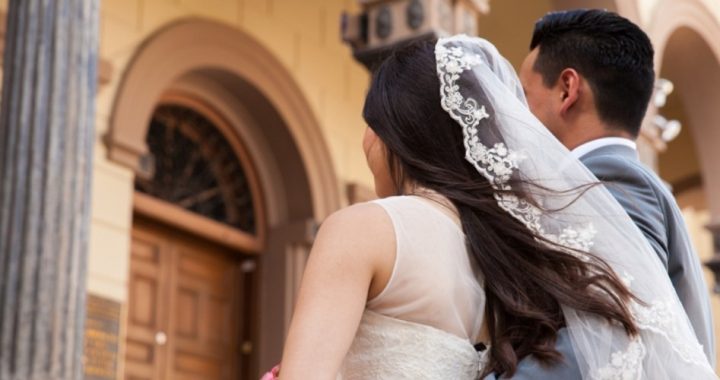
According to data from the U.S. Census Bureau, the U.S. marriage rate — defined as the number of new marriages per 1,000 people — has been falling for decades and remains low.
According to a July 28 report from Bloomberg News, Americans are delaying getting married. Specifically, the report noted that in 2015 the median age for a first-time American bride was almost 28 years old, and the median age for a first-time groom was almost 30, according to the most recent data available from the Census Bureau. (Ten years earlier, the median age was 25.5 for a first-time bride and 27 for a first-time groom.)
The reported noted that the marriage rate fell at an unusually fast pace during the economic recession of 2008 and 2009, but there is no indication that it returned to its previous rate even after the economy recovered. It cited data from the research firm IbisWorld predicting that the marriage rate will continue falling over the next five years.
According to estimates by the Wedding Report, a market-research firm specializing in the wedding industry, the number of weddings in the United States fell by 0.5 percent last year, to 2.162 million.
The decline in weddings is impacting businesses providing services to married couples, including florists, bakers, photographers, and caterers. Immediately after the 2008-2009 recession, wedding-related business revenue grew strongly — increasing by more than 4 percent a year from 2012 to 2014, reported IbisWorld. However, growth started slowing again in 2015, and revenue actually declined slightly in 2016. During the next five years, IbisWorld expects an annual growth rate of just 0.3 percent.
If the outlook for weddings is poor in this country, things are even worse in Europe. The most recent data indicates that the U.S. marriage rate is 6.9 per 1,000 people, but the average rate in the nominally Christian European Union countries is only 4.6.
Defenders of traditional morality will find the explanation that the Bloomberg report provides for the declining marriage rate in Europe troubling:
In Europe, and increasingly in the U.S., many couples are postponing marriage indefinitely, as it becomes more socially acceptable for couples to live together and have children together outside the bonds of marriage.
Living together and having children together outside the bonds of marriage was once commonly called “living in sin.” That such a lifestyle is now regarded as “more socially acceptable” says volumes about the decline of biblical morality in both the United States and Europe.
And things are going from bad to worse, if Bloomberg is correct. The report states:
One bright spot for the wedding industry is the pent-up demand for same-sex marriages. Since the U.S. Supreme Court legalized gay marriage nationwide two years ago, the Williams Institute estimates about 157,000 same-sex couples have gotten married. About 1.1 million Americans are married to someone of the same sex, the institute said last month, out of an estimated 10.7 million LGBT adults in the U.S.
Another article posted by Brides magazine on April 21 discussed why so many millennials appear not to be interested in marriage. It cited a new report from the U.S. Census Bureau titled The Changing Economics and Demographics of Young Adulthood: 1975–2016, which examined changes in adulthood over the last 40 years. And the surprising news, reported Brides, is that this “this generation might not be that interested in settling down. The [Census Bureau] report indicates that Americans between the ages of 18 and 34 are getting married less than previous generations.”
Brides noted, “The report revealed that 55 percent of these young adults don’t believe getting married and having kids are as important as pursuing their career goals and education.”
Those who believe in traditional marriage will be more encouraged by a July 27 article in the Irish Independent, however. The article noted that the number of married people in Ireland increased by almost 5 percent to 1,792,151 between the 2011 and 2016 censuses, the Central Statistics Office (CSO) revealed.
The rate was higher than the overall population increase in Ireland over the same period, which was 3.8 percent. Furthermore, noted the article, married people, including those who were remarried, made up 47.7 percent of Ireland’s population in 2016. Irish women were more likely to be married than single at the age of 33. For men, that threshold was 35.
There were some surprises, too. The number of children per family in Ireland remained unchanged since the 2011 census at 1.38 children. In developed countries, any birth rate below approximately 2.1 children born per woman is considered to be “sub-replacement fertility.” In other words, a society needs to have a birth rate of 2.1 or higher to offset deaths and sustain the population. Therefore, not even traditionally Catholic Ireland is now maintaining a “replacement fertility rate.”
Photo: Thinkstock
Related articles:
Think-tank’s Report Shows That Strong Families Create Prosperous States
Social Scientists Find Traditional Marriage a Cure for Poverty
New Study Chronicles Crisis of Traditional Families
Thousands March for Traditional Marriage in D.C.
Government Statistics: 65 Percent of Children Receive Federal Aid
Pro-Family Group Warns of Agenda Behind SPLC’s “Mix It Up” Day
Chick-fil-A President Confirms: “We support Biblical families”



